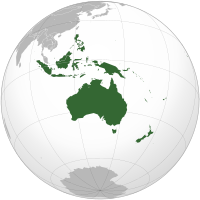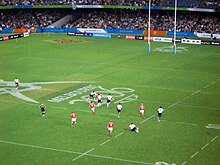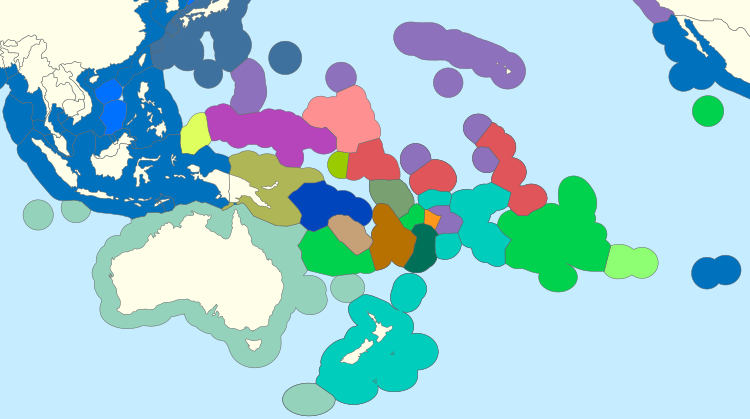Oceania: Difference between revisions
m BOT: Checking dead links; Marked 1 link with {{Dead link}} (Further info: WP:DEADLINK) |
Mariusmiti (talk | contribs) |
||
| Line 31: | Line 31: | ||
|- |
|- |
||
! style="border-top: solid 1px #ccd2d9; padding: 0.4em 1em 0.4em 0; vertical-align: top; text-align: left;" | Largest Cities |
! style="border-top: solid 1px #ccd2d9; padding: 0.4em 1em 0.4em 0; vertical-align: top; text-align: left;" | Largest Cities |
||
| style="border-top:solid 1px #ccd2d9; padding:0.4em 1em 0.4em 0; vertical-align:top;" | [[Jakarta]]<br>[[Manila]]<br>[[Sydney]]<br>[[Bandung]]<br>[[Melbourne]]<br>[[Surabaya]]<br>[[Medan]] |
| style="border-top:solid 1px #ccd2d9; padding:0.4em 1em 0.4em 0; vertical-align:top;" | [[Jakarta]]<br>[[Manila]]<br>[[Sydney]]<br>[[Bandung]]<br>[[Melbourne]]<br>[[Surabaya]]<br>[[Medan]]<br>[[Brisbane]]<br>[[Perth]]<br>[[Auckland]]<br>[[Adelaide]] |
||
|} |
|} |
||
</div></div> |
</div></div> |
||
Revision as of 19:10, 29 October 2010

Oceania is a region centered on the islands of the tropical Pacific Ocean.[1] Conceptions of what constitutes Oceania vary, with it being defined in various ways, often geopolitically or geographically. Definitions of Oceania range from the coral atolls and volcanic islands of the South Pacific (ethnologically divided into the subregions of Island Melanesia, Micronesia, and Polynesia[2]) to all islands southeast of continental Asia, including Australasia and the Malay Archipelago.[3]
In the geopolitical conception used by the United Nations, International Olympic Committee, and many atlases, the Oceanic region includes Australia and the nations of the Pacific from Papua New Guinea east, but not the Malay Archipelago or Indonesian New Guinea.[4][5][6] The term is sometimes used more specifically to denote Australasia as a geographic continent,[7][8] or biogeographically as a synonym for either the Australasian ecozone (Wallacea and Australasia) or the Pacific ecozone (Melanesia, Polynesia, and Micronesia apart either from New Zealand[9] or from mainland New Guinea[10]).
Etymology
The term was coined as Océanie ca. 1812 by geographer Conrad Malte-Brun.[3]
Definitions
Oceania

Wider Geographic Oceania.
Little of the South Pacific is apparent at this scale, though Hawaii is just visible near the eastern horizon.
| Area | 10,975,600 km2 (4,237,700 sq mi) |
|---|---|
| Population | 378 million (2010) |
| Time Zones | UTC+7 (Western Indonesian Time) to UTC-6 (Easter Island) |
| Largest Cities | Jakarta Manila Sydney Bandung Melbourne Surabaya Medan Brisbane Perth Auckland Adelaide |
Geographic Oceania
Oceania was originally conceived as the lands of the pacific ocean, stretching from the Straits of Malacca to the coast of the Americas. It comprised four regions: Polynesia, Micronesia, Malaysia (now called the Malay Archipelago), and Melanesia (now called Australasia).[11] Included are parts of three geological continents, Eurasia, Australia, and Zealandia, as well the non-continental volcanic islands of the Philippines, Wallacea, and the open Pacific. It extends to Sumatra in the west, the Bonin Islands in the northwest, the Hawaiian Islands in the northeast, Rapa Nui and Sala y Gómez Island in the east, and Macquarie Island in the south, but excludes Taiwan and the Ryukyu, Japanese, and Aleutian Islands of the margins of Asia.[12][13]
The states that occupy Oceania that are not included in geopolitical Oceania are Indonesia, Malaysia (through Malaysian Borneo), Brunei, the Philippines, and East Timor. The islands of the geographic extremes are politically integral parts of Japan (Bonin), the United States (Hawaii), and Chile (Easter Island). A smaller geographic definition also exists, which excludes the land on the Sunda plate, but includes Indonesian New Guinea as part of the Australian continent.
Ecogeographic Oceania
Oceania is one of eight terrestrial ecozones, which constitute the major ecological regions of the planet. The Oceania ecozone includes all of Micronesia, Fiji, and all of Polynesia except New Zealand. New Zealand, New Guinea, Melanesia apart from Fiji, and Australia constitute the separate Australasia ecozone. The Malay Archipelago is part of the Indomalaya ecozone. Related to these concept are Near Oceania, that part of western Island Melanesia which has been inhabited for tens of millennia, and Remote Oceania, which is more recently settled.[14]
Geopolitical Oceania
In the geopolitical conception used by the United Nations, International Olympic Committee, and many atlases, the Oceanic region includes Australia and the nations of the Pacific from Papua New Guinea east, but not the Malay Archipelago or Indonesian New Guinea.[4][15][16]
Demographics
Oceania
| Demonym | Oceanic; Oceanian | |
|---|---|---|
| Area | 8,536,716 km2 (3,296,044 sq mi) | |
| Population | 35,670,000 | |
| Countries | ||
| Dependencies |
| |
| Languages | ||
| Time Zones | UTC+8 (Australian Western Standard Time) to UTC-6 (Easter Island) (West to East) | |
| Largest Cities | Sydney Melbourne Brisbane Perth Auckland |
The demographic table below shows the subregions and countries of Oceania as broadly categorised according to the usual geopolitical definition of Oceania.[4] The information shown follows sources in cross-referenced articles; where sources differ, provisos have been clearly indicated. These territories and regions are subject to various additional categorisations, of course, depending on the source and purpose of each description.
| Name of region, followed by countries and their flags[17] |
Area (km²) |
Population | Population density (per km²) |
Capital | ISO 3166-1 |
|---|---|---|---|---|---|
| Australasia[18] | |||||
| 7,686,850 | 22,028,000 | 2.7 | Canberra | AU | |
| 268,680 | 4,108,037 | 14.5 | Wellington | NZ | |
| External territories of Australia: | |||||
| 135 | 1,493 | 3.5 | Flying Fish Cove | CX | |
| 14 | 632 | 45.1 | West Island | CC | |
| Coral Sea Islands | 3 | ||||
| 35 | 1,866 | 53.3 | Kingston | NF | |
| Melanesia[21] | |||||
| 18,270 | 856,346 | 46.9 | Suva | FJ | |
| 19,060 | 240,390 | 12.6 | Nouméa | NC | |
| 462,840 | 5,172,033 | 11.2 | Port Moresby | PG | |
| 28,450 | 494,786 | 17.4 | Honiara | SB | |
| 12,200 | 240,000 | 19.7 | Port Vila | VU | |
| Micronesia | |||||
| 702 | 135,869 | 193.5 | Palikir | FM | |
| 549 | 160,796 | 292.9 | Hagåtña | GU | |
| 811 | 96,335 | 118.8 | South Tarawa | KI | |
| 181 | 73,630 | 406.8 | Majuro | MH | |
| 21 | 12,329 | 587.1 | Yaren (de facto) | NR | |
| 477 | 77,311 | 162.1 | Saipan | MP | |
| 458 | 19,409 | 42.4 | Melekeok[23] | PW | |
| 2 | 12 | Wake Island | UM | ||
| Polynesia | |||||
| 199 | 68,688 | 345.2 | Pago Pago, Fagatogo[24] | AS | |
| 240 | 20,811 | 86.7 | Avarua | CK | |
| 163.6 | 3,791 | 23.1 | Hanga Roa | CL | |
| 3,961 | 257,847 | 61.9 | Papeete | PF | |
| 28,311 | 1,283,388 | 72.8 | Honolulu | US | |
| 260 | 2,134 | 8.2 | Alofi | NU | |
| 5 | 47 | 10 | Adamstown | PN | |
| 2,944 | 179,000 | 63.2 | Apia | WS | |
| 10 | 1,431 | 143.1 | —[25] | TK | |
| 748 | 106,137 | 141.9 | Nukuʻalofa | TO | |
| 26 | 11,146 | 428.7 | Funafuti | TV | |
| 274 | 15,585 | 56.9 | Mata-Utu | WF | |
| Total | 8,536,716 | 35,669,267 | 4.2 | ||
| Total minus mainland Australia | 849,866 | 13,641,267 | 16.1 | ||
Interpretative details and controversies

- New Zealand is the western corner of the Polynesian Triangle. Its indigenous Māori constitute one of the major cultures of Polynesia. It is also, however, considered part of Australasia.[4] More restricted definitions of the region may exclude New Zealand.[26]
- Hawaii is the northern corner of the Polynesian Triangle and is generally included in Oceania, though politically it is part of the United States. The Hawaiian language is a Polynesian member of the Oceanic language family, and Hawaiian culture is one of the major cultures of Polynesia.
- The US territories in the North Pacific are generally considered part of Oceania.
- Rapa Nui, or Easter Island, is the eastern corner of the Polynesian triangle. A Polynesian island in the eastern Pacific Ocean and part of the territory of Chile, it is generally included in Oceania, in which case the most easterly place in Polynesia and Oceania is its dependency Isla Salas y Gómez 415 km to the East.
- Australia is sometimes not included in Oceania. Terms such as Pacific Islands or South Sea Islands might be used to describe Oceania without Australia (and New Zealand). The term "Australasia" invariably includes Australia, and usually includes New Zealand, Papua New Guinea, and Island Melanesia. The term derives from austral "of the south" and Asia, meaning "south of Asia".
- Although Christmas Island and the Cocos (Keeling) Islands belong to the Commonwealth of Australia, they are nearer Indonesia than the Australian mainland, and are commonly associated with Asia instead of Oceania.[citation needed]
- Amateur radio follows the geographic rather than geopolitical boundaries of Oceania. The Worked All Continents award includes all of Indonesia and the Philippines in Oceania, though it places Easter Island with Chile and makes some other minor changes.
Religion
Religion in Oceania remains dominated demographically by Christianity. Traditional religions are often animist and prevalent among traditional tribes is the belief in evil spirits (masalai in Tok Pisin), which are blamed for "poisoning" people, causing calamity and death. In recent Australian and New Zealand censuses, large proportions of the population say they belong to "No religion" (which includes humanism, atheism, agnosticism, and rationalism). In Tonga, everyday life is heavily influenced by Polynesian traditions and especially by the Christian faith. The Bahá'í House of Worship in Tiapapata, Samoa is one of seven designations administered in the Baha'i faith.
Sport
Pacific Games
The Pacific Games (formerly known as the South Pacific Games) is a multi-sport event, much like the Olympics, (albeit on a much smaller scale), with participation exclusively from countries around the Pacific. It is held every four years and began in 1963.
Rugby League
Rugby league is a popular sport throughout Oceania, and is the national sport of Papua New Guinea[27] (the second most populous country in Oceania after Australia) and is very popular in Australia[28] and attracts significant attention across New Zealand and the Pacific Islands.[29]
Australia and New Zealand are two of the best sides in the world.[30] Australia has won the Rugby League World Cup a record nine times while New Zealand won their first World Cup in 2008. Australia hosted the second tournament in 1957. Australia and New Zealand jointly hosted it in 1968 and 1977. New Zealand hosted the final for the first time in 1985 - 1988 tournament and Australia hosted the last tournament in 2008.
Rugby Union

Rugby union is one of the region's most prominent sports.[31] Rugby union being the national sport of New Zealand,[32] Samoa,[32] Fiji and Tonga.[32] Fiji's sevens team is one of the most successful in the world, as is New Zealand's.
Australia has won the Rugby World Cup a record two times (tied with South Africa who have also won it two times). New Zealand won the inaugural World Cup in 1987. Australia and New Zealand jointly hosted the World Cup in 1987. Australia hosted it in 2003 and New Zealand is to host it in 2011.
Cricket

Cricket is a popular summer sport in Australia and New Zealand. Australia had ruled International cricket as the number one team for more than a decade, and have won the last three Cricket World Cups. New Zealand is also considered a strong competitor in the sport, with the New Zealand Cricket Team, also called the Black Caps, enjoying success in many competitions. Both Australia and New Zealand are Full members of the ICC. Fiji, Vanuatu and Papua New Guinea are some of the Associate/Affiliate members of the ICC from Oceania that are governed by ICC East Asia-Pacific. Beach Cricket, a greatly simplified variant of cricket played on a sand beach, is also a popular recreational sport in Australia.
Cricket is culturally a significant sport for summer in Oceania. The Boxing Day Test is very popular in Australia, conducted every year on 26 December at the Melbourne Cricket Ground, Melbourne.
Australian rules football
Australian rules football is the national sport in Nauru[33] and is very popular in Australia.[34] It is also very popular in Papua New Guinea.[35]
Association football (soccer)
The Oceania Football Confederation (OFC) is one of six association football confederations[36] under the auspices of FIFA, the international governing body of the sport. The OFC is the only confederation without an automatic qualification to the World Cup Finals. Currently the winner of the OFC qualification tournament must play off against an Asian confederation side to qualify for the World Cup.[37][38]
Currently, Vanuatu is the only country in Oceania to call football its national sport.
Oceania has been represented at four World Cup Finals — Australia in 1974, 2006 and 2010, and New Zealand in 1982 and 2010. As Australia and New Zealand qualified for the 2010 World Cup, it made the first time two countries from Oceania had qualified at the same time, however Australia is no longer a member of the Oceania Football Confederation, having joined the Asian Football Confederation in 2006.
See also
Notes
- ^ For a history of the term, see Douglas & Ballard (2008) Foreign bodies: Oceania and the science of race 1750–1940
- ^ "Oceania". 2005. The Columbia Encyclopedia, 6th ed. Columbia University Press.
- ^ a b "Oceania". Oxford English Dictionary (Online ed.). Oxford University Press. (Subscription or participating institution membership required.)
- ^ a b c d "United Nations Statistics Division - Countries of Oceania". Millenniumindicators.un.org. Retrieved 2009-04-17.
- ^ Atlas of Canada Web Master (2004-08-17). "The Atlas of Canada - The World - Continents". Atlas.nrcan.gc.ca. Retrieved 2009-04-17.
- ^ Current IOC members.
- ^ "Encarta Mexico "Oceanía"". Mx.encarta.msn.com. Archived from the original on 2009-11-01. Retrieved 2009-04-17.
{{cite web}}: Unknown parameter|deadurl=ignored (|url-status=suggested) (help) - ^ Lewis, Martin W. (1997). The Myth of Continents: a Critique of Metageography. Berkeley: University of California Press. p. 32. ISBN 0-520-20742-4, ISBN 0-520-20743-2.
Interestingly enough, the answer [from a scholar who sought to calculate the number of continents] conformed almost precisely to the conventional list: North America, South America, Europe, Asia, Oceania (Australia plus New Zealand), Africa, and Antarctica.
{{cite book}}: Unknown parameter|coauthors=ignored (|author=suggested) (help) - ^ Udvardy. 1975. A classification of the biogeographical provinces of the world
- ^ Steadman. 2006. Extinction & biogeography of tropical Pacific birds
- ^ D'Urville, Jules-Sébastien-César Dumont. "On the Islands of the Great Ocean". The Journal of Pacific History. 38, No. 2. Taylor & Francis, Ltd.
{{cite journal}}: Unknown parameter|coauthors=ignored (|author=suggested) (help) - ^ MacKay (1864, 1885) Elements of Modern Geography, p 283
- ^ Douglas & Ballard (2008) Foreign bodies: Oceania and the science of race 1750–1940
- ^ Ben Finney, The Other One-Third of the Globe, Journal of World History, Vol. 5, No. 2, Fall, 1994.
- ^ Atlas of Canada Web Master (2004-08-17). "The Atlas of Canada - The World - Continents". Atlas.nrcan.gc.ca. Retrieved 2009-04-17.
- ^ Current IOC members.
- ^ Regions and constituents as per UN categorisations/map except notes 2-3, 6. Depending on definitions, various territories cited below (notes 3, 5-7, 9) may be in one or both of Oceania and Asia or North America.
- ^ The use and scope of this term varies. The UN designation for this subregion is "Australia and New Zealand."
- ^ New Zealand is often considered part of Polynesia rather than Australasia.
- ^ a b Christmas Island and Cocos (Keeling) Islands are Australian external territories in the Indian Ocean southwest of Indonesia.
- ^ Excludes parts of Indonesia, island territories in Southeast Asia (UN region) frequently reckoned in this region.
- ^ Papua New Guinea is often considered part of Australasia and Melanesia. It is sometimes included in the Malay Archipelago of Southeast Asia.
- ^ On 7 October 2006, government officials moved their offices in the former capital of Koror to Melekeok, located 20 km northeast of Koror on Babelthuap Island.
- ^ Fagatogo is the seat of government of American Samoa.
- ^ Tokelau, a domain of New Zealand, has no capital: each atoll has its own administrative centre.
- ^ Max Cryer, Curious Kiwi Words, 2002, p153 - "A larger portion of the rest of the world calmly refers to this geographic area as Oceania, a term many New Zealanders have never heard, let alone used."
- ^ "MSN Groups Closure Notice". Groups.msn.com. 2008-10-23. Retrieved 2009-04-17.
- ^ "Football in Australia - Australia's Culture Portal". Cultureandrecreation.gov.au. 2008-03-28. Retrieved 2009-04-17.
- ^ "Rugby League Football - 1966 Encyclopaedia of New Zealand". Teara.govt.nz. 1908-06-13. Retrieved 2009-04-17.
- ^ Wilson, Andy (2009-11-05). "southern hemisphere sides are a class apart". London: guardian.co.uk. Retrieved 2010-06-17.
- ^ "Oceania Rugby Vacations". Real Travel. Retrieved 2009-04-17.[dead link]
- ^ a b c "How many national sports are there". WikiAnswers. Retrieved 2009-04-17.
- ^ "Nauru AFL team to play in International Cup". solomonstarnews.com. 2008-04-16. Retrieved 2009-04-17.
- ^ "Australian rules football (sport) - Britannica Online Encyclopedia". Britannica.com. Retrieved 2009-04-17.
- ^ "pure AFL ... purely Papua New Guinea". Afl Png. Retrieved 2009-04-17. [dead link]
- ^ "FIFA confederations". Fifa.com. Retrieved 2009-04-17.
- ^ FIFA world cup 2010 - Oceania preliminary competition
- ^ "FIFA world cup 2010 - qualifying rounds and places available by confederation". Fifa.com. 2009-04-03. Retrieved 2009-04-17.














